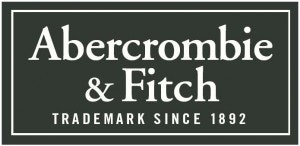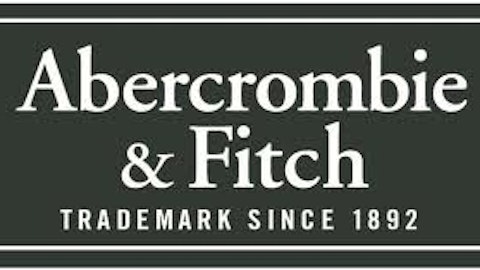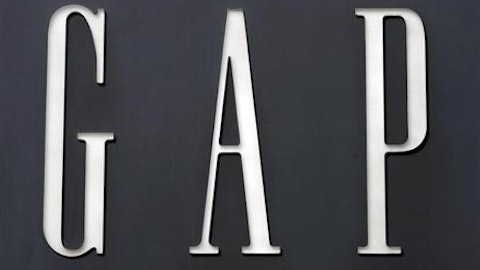
Back in March, I proclaimed that Abercrombie & Fitch Co. (NYSE:ANF) was headed toward failure, due to its operating inefficiencies, shrinking margins, lack of pricing power and reckless international expansion. It appears that my forecast was fairly correct, and that industry peers, such as The Gap Inc. (NYSE:GPS) and even American Eagle Outfitters (NYSE:AEO), could be better investments than Abercrombie in the retail apparel sector.
A disastrous first quarter
For its first quarter, Abercrombie & Fitch Co. (NYSE:ANF) reported a net loss of $0.09 per share, an improvement over a loss of $0.25 per share a year ago, but still fell short of the Thomson Reuters consensus estimate for a loss of $0.05. Revenue also slid 9% year-on-year to $838.8 million, which also missed the analyst forecast of $941.66 million.
The Gap Inc. (NYSE:GPS), in comparison, reported a profit of $0.71 per share for its first quarter, up from $0.47 per share a year ago. Revenue rose 6.9% to $3.73 billion. Gap topped analyst estimates on the bottom line while meeting expectations for its top line growth.
Even American Eagle Outfitters (NYSE:AEO), which competes for Abercrombie & Fitch Co. (NYSE:ANF)’s core teen demographic, reported better earnings. American Eagle’s first quarter profit dropped 18.2% to $0.18 per share, while its revenue declined 4.1% to $679.5 million. While those results weren’t pretty, they still looked better than Abercrombie’s disastrous first quarter numbers.
Same-store sales decline
Abercrombie & Fitch Co. (NYSE:ANF)’s consolidated same-store (brick-and-mortar and direct-to-consumer combined) sales plunged 15% from a year earlier. Brick-and-mortar locations fared worse, with a 17% decline, while direct-to-consumer sales (including e-commerce), slid 6%. Its three primary brands – Abercrombie & Fitch, Abercrombie Kids and Hollister – reported consolidated same-store sales declines of 13%, 5% and 18%, respectively.
By comparison, The Gap Inc. (NYSE:GPS), which owns Old Navy, Gap and Banana Republic, reported 2% company-wide same-store sales growth. Gap and Old Navy both posted 3% same-store sales growth, while sales at Banana Republic remained flat. American Eagle reported a 5% decline in consolidated same-store sales, while the average retail selling price per unit decreased by 1%. This indicates that American Eagle could be willing to reduce prices to drive sales growth.


However, a look at long-term trends in the operating margins of these three competitors indicates that they all tend to raise and slash prices in similar cyclical patterns. Yet total operating expenses at all three companies have risen over the past five years, which indicates that promotional costs will continue to rise while they wrestle with each other and other major players in the industry, such as H&M, Forever 21, Urban Outfitters, Inc. (NASDAQ:URBN) and Aeropostale, Inc. (NYSE:ARO).
Falling out of fashion?
There is a sentiment in the retail sector that big branded logo apparel, such as those sold by Abercrombie & Fitch Co. (NYSE:ANF), its subsidiary Hollister and its rival Aeropostale, Inc. (NYSE:ARO), are quickly losing their appeal with teen shoppers. The Gap Inc. (NYSE:GPS) noticed this trend many years ago, and has since reduced the amount of large logo-branded apparel in favor of a wider variety of styles.
Smaller competitors such as H&M and Forever 21 have also been more agile than Abercrombie & Fitch Co. (NYSE:ANF), rotating fashions at a much faster rate to keep younger shoppers interested. As a result, Abercrombie lowered its full-year guidance from $3.35-$3.45 to $3.15-$3.25, which missed the consensus estimate of $3.49 by a wide margin. Contradictory comments from the CEO and the company’s official guidance also frustrated investors.
Let me contradict myself
CEO Mike Jeffries stated, “Comparable sales trends progressively improved during the quarter and with the inventory headwinds largely behind us, we expect to see continued sequential improvement in the second quarter.” Meanwhile, the company’s official guidance stated that it expects “comparable sales, including direct-to-consumer to be slightly down for the balance of the year.”
In other words, Abercrombie & Fitch Co. (NYSE:ANF)’s outlook for the remainder of 2013 is a murky mess that the CEO and his executives can’t even agree on. With double-digit same-store sales decline and no notable strength in e-commerce, I’m inclined to take the more pessimistic view of the company’s future.
Damage control
Yet a gloomy financial outlook for the rest of the year isn’t Abercrombie & Fitch Co. (NYSE:ANF)’s only problem. Regarding his widely circulated inflammatory comments, Jeffries has issued an official apology on the company’s Facebook page, stating that his comments were taken “out of context” and that the company is “completely opposed to any discrimination, bullying, derogatory characterizations or other antisocial behavior based on race, gender, body type or other individual characteristics.” So far, Jefferies’ apology hasn’t generated much sympathy.
In Jefferies’ defense, perhaps a company has the right to strive to be “exclusionary.” After all, would Louis Vuitton cater to a lower-income demographic that demanded $30 handbags? Should Armani start producing plus-size clothing simply because there might be a market for it? I doubt it, but there’s a big difference between keeping a company’s brand exclusionary and pompously declaring it in a public interview.
The Gap Inc. (NYSE:GPS) and American Eagle shareholders are probably relieved that their respective CEOs, Glenn Murphy and Robert Hanson, have kept a much lower public profile.
The Foolish Fundamentals
In conclusion, let’s compare Abercrombie & Fitch’s fundamentals to its primary competitors.
Forward P/E | 5-year PEG | Price to Sales (ttm) | Return on Equity (ttm) | Debt to Equity | Profit Margin | |
Abercrombie & Fitch | 11.95 | 0.92 | 0.94 | 12.64% | 3.52 | 5.25% |
Gap, Inc. | 13.41 | 1.37 | 1.23 | 40.18% | 43.06 | 7.25% |
American Eagle Outfitters | 11.83 | 1.22 | 1.12 | 20.02% | No debt | 6.68% |
Advantage | American Eagle | Abercrombie | Abercrombie | Gap | American Eagle | Gap |
Source: Yahoo Finance, May 24 (does not include recently reported 1Q figures)
On a fundamental basis, Abercrombie & Fitch Co. (NYSE:ANF) doesn’t look too bad, and if analysts’ 5-year projections are correct, then it could actually grow faster than either The Gap Inc. (NYSE:GPS) or American Eagle Outfitters (NYSE:AEO). However, Abercrombie’s same-store sales plunge of 15% is a major red flag that suggests that the appeal of its three primary brands is waning – a factor that is hard to account for with a 5-year PEG ratio.
Both Gap and American Eagle have a wider variety of brands. The Gap Inc. (NYSE:GPS) offers a tiered pricing system with its three main brands, and also owns Athleta, an athletic apparel brand that is designed to rival. American Eagle Outfitters (NYSE:AEO) owns lingerie brand, which rivals Victoria’s Secret, and 77kids, which is positioned against Abercrombie Kids. Both companies have shown balanced strength across their brands, which can help offset losses from an individual brand. Abercrombie & Fitch Co. (NYSE:ANF), on the other hand, has three brands that seem to fall in tandem.
I’ve said it before, and I’ll say it again – avoid Abercrombie & Fitch Co. (NYSE:ANF). Despite a shifty change to its accounting method, which preserves the value of its inventory unless it expects to sell the merchandise below cost, this is the same old company that has been losing its appeal for over a decade.
The article Is This Retailer About to Bite the Dust? originally appeared on Fool.com.
Leo is a member of The Motley Fool Blog Network — entries represent the personal opinion of the blogger and are not formally edited.
Copyright © 1995 – 2013 The Motley Fool, LLC. All rights reserved. The Motley Fool has a disclosure policy.



